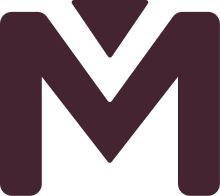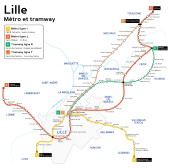Lille Metro
The Métro Lille , together with the tram and bus network, forms the local public transport in the Lille agglomeration , which is the northernmost French agglomeration with more than one million inhabitants around the city of Lille and extends to the Belgian provinces of Hainaut and West Flanders . Opened in 1983 , the subway network comprises two lines and was the first subway system to use VAL technology. This makes the Lille Metro one of the few subways in the world that is operated automatically, i.e. without a driver. The operator of the metro network is Transports en commun de la métropole lilloise (Transpole) .
Line network
Lines
The Lille metro consists of two lines. Together these are currently 45.5 kilometers long and have 62 stations. Depending on the station, the metro trains run between 5:00 a.m. and 6:00 a.m. and 11:00 p.m. to 12:30 a.m. at night. The train interval is around 60 seconds at peak times.
| line | colour | route | opening | length | Train stations |
|---|---|---|---|---|---|
| 1 | yellow | Quatre Cantons - Stade Pierre-Mauroy ↔ CHU - Eurasanté | 1983 | 13.5 km | 18th |
| 2 | red | Saint-Philibert ↔ CH Dron | 1989 | 32 km | 44 |
Stations
The platform screen doors typical of driverless systems are characteristic of the metro stations . In addition, 47 of the 62 stations were individually designed architecturally and artistically by various artists and thus show a great variety of modern architecture.
history
Lille, in the north of France, forms the fourth largest agglomeration in the country with its numerous surrounding municipalities with more than one million inhabitants . The introduction of a metro system became necessary for this metropolitan area.
In 1968 the Communauté Urbaine de Lille (CUDL) was founded, which, among other things, set itself the goal of improving local public transport due to an expected traffic chaos in the future. According to studies, this scenario of traffic chaos could only be prevented if public transport had a high frequency and an independent route. The choice of a suitable transport system was still open by the CUDL.
Several criteria have been established for such a system. On the one hand, the means of transport should provide the ideal travel speed possible; on the other hand, a high frequency during rush hour had to be possible, even though only an estimated 6,000 people per hour could be transported. As a result, a public transport concept for the city of Lille and its surrounding communities was put out to tender internationally in 1971, which should meet several conditions. This included a separate track structure, a travel speed of more than 30 km / h, a train frequency of one train per minute, fully automatic operation without a driver and a small clearance profile . In addition, the operating and construction costs should be kept low in order to facilitate the realization of the project.
As early as 1972, a corporate consortium led by MATRA was declared the winner of this competition. This enabled the development of the VAL system (VAL: Véhicule automatique léger, light, automatically operated train). In 1973 and 1974, two prototypes were tested at a test site . After final examinations and assessments, the Conseil de la Communauté urbaine de Lille (German Council of the City of Lille ) decided on March 29, 1974 to build a system of four VAL lines. Priority was given to the section between Villeneuve d'Ascq and Lille.
The construction of the factory facilities at what will later be the terminus of Line 1, 4 Cantons in Villeneuve d'Ascq, took place in 1977. Construction work on the line 1 began the following year. During construction, a few corrections were made to the original concept. The municipal association of Lille- Roubaix - Tourcoing demanded that turning loops should not be constructed at the ends of the route, as originally planned, and that bidirectional vehicles should not be used. Without this appeal, the association had directional vehicles have been sufficient for the operation of the track. The criticism from the population was also countered with the partial over-planning of the route, which delayed the completion and commissioning of the system.
Construction work ended on April 25, 1983, when the first line between 4 Cantons and République was opened in the presence of the then French President François Mitterrand . The metro could be viewed for two weeks as part of the open house , and around 400,000 people took advantage of this offer. Commercial operation of the underground began on May 16, 1983. The system worked very well and was successful. As a result, in February 1984 the decision was made to build a second metro line on this technical basis. There was 1 to the line, wherein the Latin additional designation to indicating a branch line of the regular line. 1 On May 2, 1984, the second section between République and CHR B-Calmette was inaugurated. Since then, the route has reached a length of 13.5 kilometers, 8.5 kilometers of which are underground. Line 1 has not been extended to date.
In the mid-1980s, there was a controversial discourse on whether the metro system should be expanded at the expense of the tram network in the region. As a result of this dispute, the realization prevailed that the tram network should function in addition to the metro. To make the tram more attractive, it was planned to modernize it in the coming years.
Furthermore, one concentrated on the construction of the line 1bis. A first section of this line was completed on April 3, 1989 between St-Philibert and Gare (today Gare Lille Flandres ). With the first extension of the route from Gare Lille Flandres to the new TGV station Gare Lille Europe on May 5, 1994, the name was also changed to Line 2, as it lost the character of a branch line of Line 1.
In the following years the line was continuously extended: 1995 to Fort de Mons , 1999 to Tourcoing-Center and in 2000 the Belgian border was almost reached with the CH Dron station . Line 2 is currently the longest automatic line in the world with 31.7 kilometers and 43 stations.
Expansion and planning
An extension of Line 1 to Lille-Lesquin Airport has been considered for many years . This extension can take place from the end of the CHR B-Calmette route as well as from 4 cantons with an additional 4.5 km route. An extension of the route from CHR B-Calmette would have the advantage of opening up the communities of Wattignies, Ronchin and Fâches-Thumesnil. However, this extension of the metro line is in competition with a tram-train project. At the present time, the extension to Wattignies or the airport is unlikely, but an extension by one station from CHR Calmette is being considered in order to develop the new "Eurasanté" industrial park.
There are also plans to let the trains run in multiple units , as the platforms have been 52 m long since they were built (twice as long as the vehicles). During the rush hour, the trains are regularly overcrowded despite the one-minute intervals, although further increase in intervals is not possible for operational reasons. However, the purchase of the additional vehicles is estimated at 400 million euros, which is why implementation will not be considered until around 2015-2017.
There are plans for line 2 to extend the route from St. Philibert to Perenchies on the one hand and to extend it from CH Dron to the city of Mouscron in Belgium . In the future there could be several branches from Roubaix, possibly to Hem and Wattrelos . But the extension of the metro route depends not only on the will of the municipalities concerned but also on legal provisions between France and Belgium, which encounter difficulties and thus jeopardize the implementation of this project.
The construction of a third line has currently been postponed, the connection is served by a bus line. In the long term, this axis could be served by a tram train .
vehicles
The vehicles are a central component of the fully automatic VAL system. For this reason, the new vehicle type VAL 206 was specially developed for this subway system . In 2000 a second generation, the VAL 208 , was put into operation on Line 1.
The metro trains of the VAL system are very different from models of conventional metro vehicles. The trains run as a two-car unit, which is 26.14 m long, 2.06 m wide, 3.25 m high and has an empty weight of around 28 t. This results in an unusually small clearance profile for subway systems .
Each of the two cars has two axles with two rubber wheels each and four horizontally arranged wheels with rubber tires. The latter exert pressure on the guide rail and thus guide the carriage. Inside each of the rubber wheels there is an additional tire to prevent deformation in the event of damage. This ensures that, in the event of an incident, the vehicles can drive at least to the next station.
Individual evidence
- ↑ Lille - Die Metropole , in: Urban renewal yearbook 2006/07 of the working group Urban renewal at German-speaking universities, Institute for Urban and Regional Planning of the TU Berlin, ed. von Altrock, Uwe et al., Universitätsverlag der TU Berlin, ISBN 978-3-7983-2029-1 , p. 358ff.



